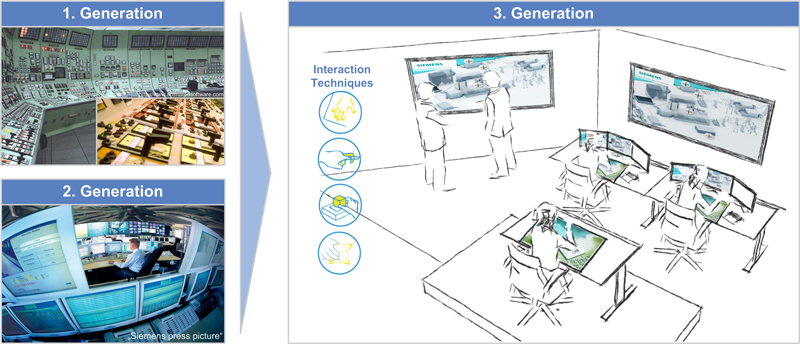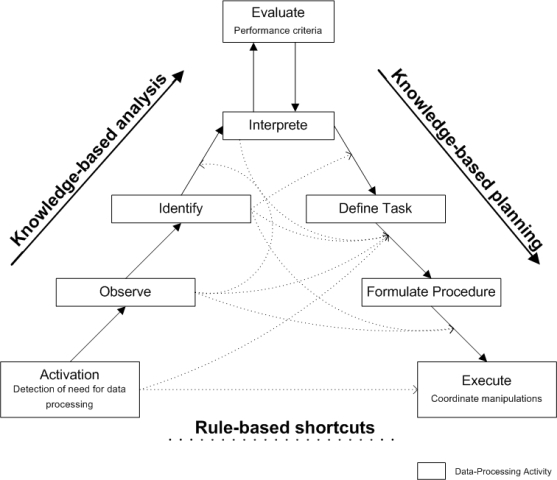Holistic Workspace
The Next Generation Workplace in Control Room

Members
Tobias Schwarz, Simon Butscher, Jens Müller, Mathias Heilig, Harald Reiterer
Description
The project “Holistic Workspace” is concerned with the following questions: "How will the workspace of control rooms in the future look like? How can new technologies and supporting systems assist operators with their daily work?"
Research Goals
Within the project’s scope, current workplaces of different domains are viewed and analyzed holistically. Based on this analysis, considering new technologies and approaches – as e.g. the principles of “reality-based interaction” – a holistic concept of today’s workplace is going to be developed. The next generation of control room design also considers previous generations in case they have proven themselves. So, a new and innovative concept evolves, perfectly uniting the benefits of former developments.

At this juncture, a system that considers user’s experiences and skills in order to support him to accomplish his tasks and to integrate him into his working environment sees the light of the day
Motivation
Today, process management is marked by the use of closely geared human-machine systems, highly relevant to security [1]. Due to a steadily increasing automation level, the people controlling those systems, the so-called operators, have to deal with a high degree of complexity. This claims superior requirements to the human and can impose excessive demands on users caused by information flood. Thus, making the complexity controllable is a big challenge of today’s human-machine-interface design. In order to adequately support the operators it is highly necessary to adapt systems to human skills and not vice versa. Due to the steadily increasing competitive pressure, this “usability of systems” has also become a crucial factor to advance customer loyalty. In collaboration with a well-known industry partner, the objective of this project is to optimize operators’ workspaces in control rooms by developing a forward-looking and holistic workstation. The topic “control room” has large cross-sector importance for the cooperation partner, whether it concerns tunnel surveillance, power stations, energy distribution facilities, production of electricity and many more. Nevertheless, different and partial parallel developments can be encountered in all those sectors. Based on their background, developers of operational systems generally have a very technical and function-oriented view on the system design. Additionally, today’s developments are characterized by a focus on the particular product - the composition of all devices at the workplace is nearly never recognized as an important factor of control room design. Thus, machine-oriented concepts arise in which users and work organization have to fit to technical guidelines and on-site combination of single devices (“human pull” instead of “technology push”). According to this, users do not operate at homogenous workplaces but have to handle a conglomeration of many different individual units.
Research Approach
A concentrated, holistic and broad view on the issue “control room” as claimed by this project can make an important contribution to the exchange of knowledge and the use of synergies between sectors of industry. It can additionally provide a solution which merges different modules and devices into one, consistent interface without losing track of the human being. Thus, psychological constructs like perception, planning and regulating courses of action as well as understanding human errors and their contribution to accidents are of major importance for the project progression.
Project Schedule
In order to get a better notion of users’ needs and expectations, the currently deployed systems that should aid the operator to fulfill his tasks are analyzed. Thus, work’s starting point is a comprehensive, cross-sectional contextual inquiry [2] on-site, i.e. at tunnel surveillance, energy distribution or operative control rooms (fire department, police). The results of the contextual inquiry are a detailed description of actual using conditions at real workplaces (typical points of departure, typical activities and working steps, context-specific difficulties, exceptions, visions) in terms of context scenarios. By the use of adequate abstractions, generic context scenarios can be deduced from the specific ones. Based on this and considering new technologies and approaches, a generic, modular concept for future “holistic workspace” is developed. General principle of concept development is a system that supports the user to exercise his tasks and to integrate him into his work environment, considering his experience and abilities at the best.In order to evaluate the concept, a prototype for a specific use-case is developed. Afterwards, suitability for daily use is tested with real users. A critical reflection of the elaborated concept and an outlook finalizes the scientific work.In the following, more information on completed and current work steps is provided. Additionally, process management in general and research findings on human errors are presented.

Work Steps
Task Analyses (Contextual inquiry)
In order to ensure a user-centered optimization of control rooms, a cross-sectional analysis (e.g. power stations, air traffic control, open cast mining) was realized in order to survey the needs and expectations of current control room staff. For this purpose, on-site contextual inquiries [2] were conducted.
This kind of socio-scientific research method permits the direct study of operators in their natural working environment, an indisputable contribution to a high outcome quality. The real terms of operators’ use as well as the functional requirements to a computer-based system are gathered at great length by detecting typical activities (work steps) and context-specific difficulties.
For this purpose, operators were observed while doing their daily work. In contrast to the systematic observation often used in the empirical socio-scientific research, behavioral monitoring in contextual inquiry not only allows, but even demands the participation of the researcher due to deeper qualitative insights resulting from the interaction between observer and the person being observed. At this juncture, objective criteria (e.g. particular steps at the execution of an action) as well as subjective and psychological criteria (e.g. validation of a certain subsystem, cognitive processes before/while/after the execution of an action) play a decisive role. Therefore, in the scope of a participant observation, subjects were also asked to think aloud, i.e. to constantly reflect on their internally subsiding cognitive processes.
In addition to qualitative data, contextual inquiries also involve surveying quantitative information by conducting structured expert interviews. With this approach operators, as experts for their occupational area, were asked about their daily work. They got the chance to talk about the benefits and disadvantages of their workplace and operations and thus, they obtained the possibility to directly influence prospective developments in the area of control rooms. With the matter in hand, additional questions on new interaction technologies were added to the interviews in order to investigate the potential use of more intuitive control panels in the future.
Current work: Concept Development
Uniting the advantages of former developments in the sector of control room design with new interaction technologies, a multiple touch system providing old school interaction elements like control dials may be an innovative, practicable and, due to the results of the contextual inquiry, broadly accepted approach towards future. Additionally, reduction of monitors and devices at the workplace are a second scope. Fig. 3 demonstrates a first sketch of these basic concept ideas.

Background Information about Related Topics
Process Management
In recent years, the view on the operators’ routine has changed dramatically. While former definitions describe the operators’ main task as “surveillance control” [3], newer definitions regard operators’ duties as “active localization of malfunctions and mistakes” [1]. That is, active recognition of exceptions and anomalies within the system has turned to rather passive hypothesis testing on the localization of malfunctions. Although the operators continue to contribute to the process actively, the role of operators has changed from users to observers due to the increasing degree of system automation within the last years. Today, the operators’ primary task is to assure a well-regulated process cycle in the application system to observe and to control. At this juncture, “normal mode” and “faulty operation” have to be substantially distinct.
While “normal mode” determines most of the time within supervisory control, asking a high and constant level of overview, concentration and sense of responsibility, “faulty operations”, although happening very rare, make great demands on the operators’ creativity, flexibility and troubleshooting ability. Jens Rasmussen [4] has developed a model to visualize the cascade of activities necessary to handle such anomalies (see fig. 4). It visualizes the cognitive processes necessary to generate problem solutions in an extreme situation. Constructed like a ladder, it shows the rising process of problem analyzing, the moment of decision making as the top the thinking process and the descending process of action planning. Cognitive shortcuts can support the decisive process, abridging the way from analyzing to planning. At this juncture, cognitive errors like heuristics can play an important role and lead to fallible decisions.

Particularly with regard to faulty operations, requirements towards technical systems increase as they have to be able to take control of situations, in which extensive, well-defined, quick and systematic analysis and reaction is needed. Although today’s highly automated systems provide those possibilities, they come along with a certain disability of the operators, causing a diffusion of responsibility with possibly fatal outcomes. Thus, a holistic view on the operators’ work must consider technical possibilities as well as their constraints of responsibility without assisting information overload or human errors.
Human Errors
Regarding serious incidents with fatal consequences (e.g. Chernobyl), often operators and their malpractice are blamed to be the cause of the disaster. Psychological research on planning and regulating courses of action argues with the agents of human mistakes at work.
References
[1] Mumaw, R. J., Roth, E. M., Vicente, K. J., Burns, C. M., (2000): There is More to Monitoring a Nuclear Power Plant than Meets the Eye. Human Factors; The Journal of the Human Factors and Ergonomics Society, pp. 36-55.
[2] Beyer, J. and Holtzbaltt, K., (1997): Contextual Design: Defining Customer-Centered Systems, Morgan Kaufmann
[3] Sheridan, T.B., (1987): Supervisory Control. In: G. Salvendy (Ed.): Handbook of Human Factors, John Wiley and Sons, pp. 1243-1268.
[4] Rasmussen, J., (1984): Strategies for State Identification and Diagnosis in Supervisory Control Tasks, and Design of Computer-Based Support Systems. Advances in Man- Machine Systems Research, Vol.1, Denmark, pp. 139-193.
Publication list
